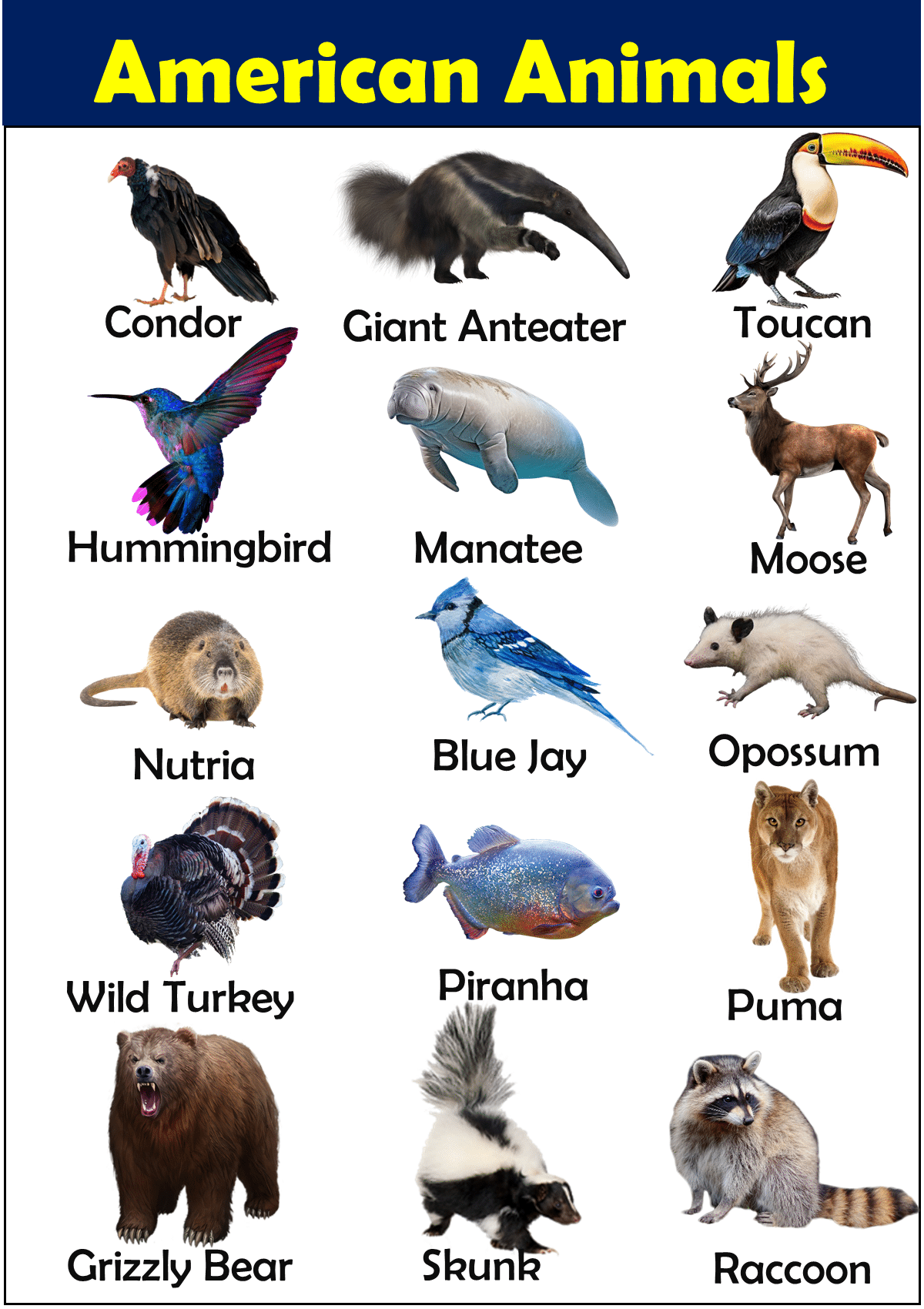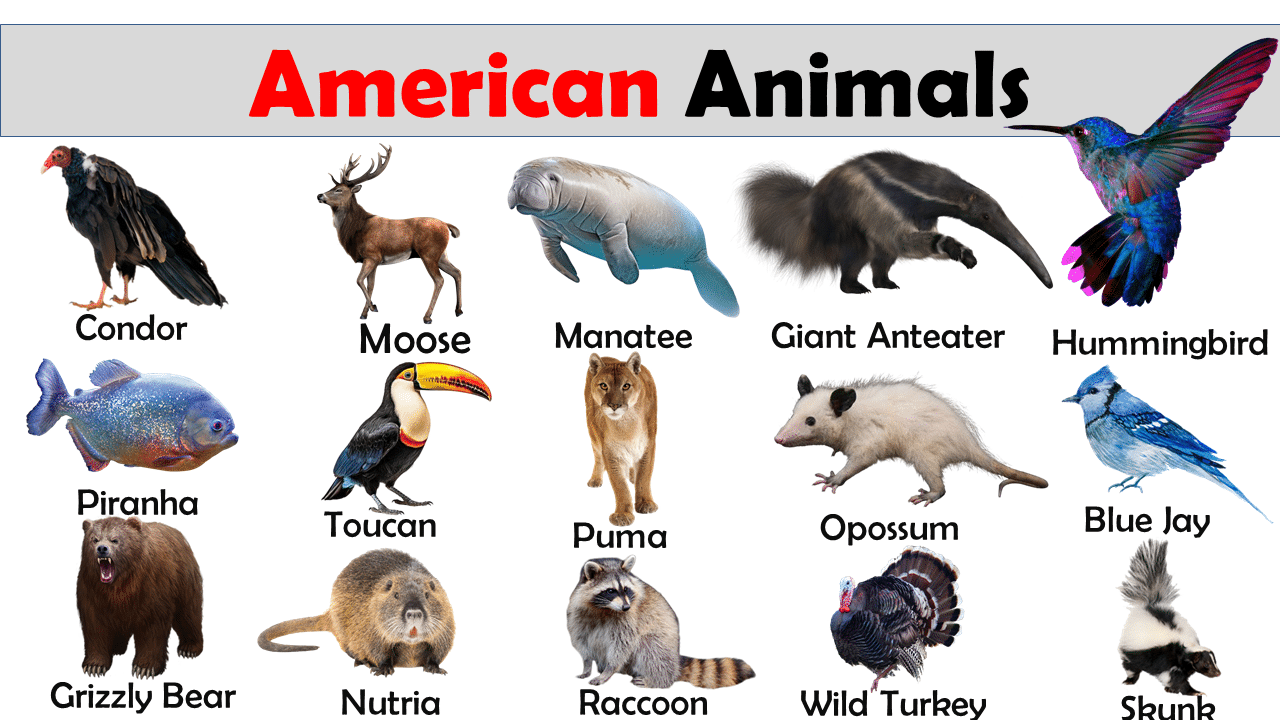America is a vast land filled with diverse landscapes and equally diverse wildlife. In this blog post, we’ll explore some of the unique animals that call America their home, from the majestic bald eagle soaring in the sky to the sneaky raccoon exploring the city streets at night. You’ll learn about different creatures that live across various American environments, their habits, and their roles in nature. This will be a fun way to expand your English vocabulary while discovering some fascinating facts about American animals!
What are American Animals?
American animals refer to the diverse range of wildlife found across the North, Central, and South American continents. This extensive list includes species from the frozen Arctic tundras of the north to the tropical rainforests of the south, showcasing the rich biodiversity of the Americas.
List of American Animals
- Bald Eagle
- American Bison
- North American Beaver
- American Alligator
- California Sea Lion
- Grizzly Bear
- Mountain Lion
- Moose
- American Black Bear
- Pronghorn Antelope
- Eastern Gray Squirrel
- Monarch Butterfly
- American Crocodile
- Canadian Lynx
- Arctic Fox
- North American Elk
- Raccoon
- American Red Fox
- Wood Bison
- Blue Jay
- American Robin
- Northern Cardinal
- White-tailed Deer
- Alaska Moose
- Wild Turkey
- Puma
- Roadrunner
- Gila Monster
- Northern Pike
- Opossum
- Anaconda
- Scarlet Macaw
- Jaguar
- Ocelot
- Capybara
- Howler Monkey
- Green Anaconda
- Sloth
- Toucan
- Amazon River Dolphin
- Spectacled Bear
- Piranha
- Tapir
- Giant Anteater
- Manatee
- Nutria
- North American Porcupine
- Skunk
- Sea Otter
- Humpback Whale
- Grey Wolf
- Coyote
- Elk
- Harpy Eagle
- Red-tailed Hawk
- Hummingbird
- Condor
- Alpaca
- Vicuña
- Saguaro Cactus Wren
- Rattlesnake
- Black Widow Spider
- Coral Snake
- Great White Shark
- Leatherback Sea Turtle
- Sockeye Salmon
- Florida Panther
- Snowy Owl
- Canadian Goose
- Polar Bear
Explore More Animal Vocab:
Arctic Animals | Tundra Animals | Mammals Animals

American Animals Vocabulary and Their Facts
1. Bald Eagle
The Bald Eagle, a national symbol of the United States, is a large bird of prey known for its white head and tail contrasting with its dark body. These eagles are found near large bodies of open water with abundant food supplies and old-growth trees for nesting. They have excellent vision and can dive at speeds over 100 mph to catch prey with their powerful talons.
2. American Bison
Once roaming the grasslands of North America in massive herds, the American Bison is the continent’s largest land animal. These animals play a critical ecological role, influencing vegetation and soil health through their grazing. Conservation efforts have helped their numbers recover from near extinction.
3. North American Beaver
The North American Beaver is an aquatic architect whose dams help maintain wetlands, crucial for biodiversity. Beavers are second only to humans in their ability to reshape their environment. Their activities can create ponds that support a complex ecosystem benefiting numerous plants and animals.
4. American Alligator
Found primarily in the Southeastern USA, the American Alligator is a formidable reptile with a powerful bite. Alligators play a key role in their ecosystem as apex predators and engineers, creating “gator holes” that provide habitats for other wildlife during dry spells.
5. California Sea Lion
California Sea Lions are playful and intelligent mammals known for their loud barks and sociable nature. They are highly adaptable, living along the Pacific coast of North America. These pinnipeds are skilled swimmers and can dive deep to find squid and fish.
6. Grizzly Bear
The Grizzly Bear, recognizable by its distinct hump and grizzled fur, is a symbol of the wilderness. Primarily found in the western USA and Canada, grizzlies are omnivores that eat a varied diet, from berries and roots to large mammals. They play a significant role in the ecosystem as both predator and scavenger.
7. Mountain Lion
Also known as the cougar or puma, the Mountain Lion is a solitary and elusive cat. They have a vast range that extends from Canada to South America. Mountain lions are top predators, regulating the populations of other species and thus maintaining the health of their habitat.
8. Moose
The Moose is the largest member of the deer family, distinguished by its massive antlers and long legs. Found in northern forests across North America, moose are browsers that significantly affect their ecosystems by altering forest structure and nutrient cycling.
9. American Black Bear
The American Black Bear is the most common bear species in North America. These bears are highly adaptable, living in forests, mountains, and swamps. They are omnivores with diets that can include fruit, nuts, fish, and insects, depending on their environment.
10. Pronghorn Antelope
The Pronghorn is notable for its incredible speed, second only to the cheetah among land animals. It is not a true antelope but has distinct white fur and hollow hair. Pronghorns are native to the grasslands of western North America and their speed is an evolutionary trait from outrunning now-extinct predators.
11. Eastern Gray Squirrel
The Eastern Gray Squirrel is a common sight in North American parks and backyards. These rodents are known for their agility in trees and their habit of burying nuts, which contributes to forest regeneration. They play a crucial role in shaping woodland areas by affecting seed dispersion.
12. Monarch Butterfly
The Monarch Butterfly is famous for its incredible mass migration from North America to Mexico. These orange and black butterflies are dependent on milkweed plants, which provide food for their larvae and a defense mechanism against predators due to the plant’s toxins, which they store in their bodies.
13. American Crocodile
The American Crocodile is found in the coastal areas of South Florida, the Caribbean, and parts of Central America. Less aggressive than their alligator cousins, these reptiles are apex predators in their environments, helping to control fish and mollusk populations.
14. Canadian Lynx
The Canadian Lynx, a medium-sized cat, thrives in the boreal forests of Canada and northern United States. Known for their thick fur and tufted ears, lynxes primarily prey on snowshoe hares, and their population cycles mirror those of their prey, illustrating a critical predator-prey dynamic.
15. Arctic Fox
The Arctic Fox, adapted to living in cold environments, has fur that changes color with the seasons for camouflage. They play a vital role in the tundra ecosystem, preying on small mammals and birds and scavenging leftovers from larger predators, helping to keep their environment clean and free of carrion.
16. North American Elk
The North American Elk, or wapiti, is one of the largest species within the deer family, found across various regions of North America. Known for their impressive antlers, which males shed and regrow each year, elks play a significant role in cultural history and ecosystems by influencing forest and meadow ecology through grazing.
17. Raccoon
Raccoons are versatile and adaptable mammals recognized by their masked faces and ringed tails. They are omnivorous and notorious for their ability to open containers and enter homes in search of food. Raccoons are important urban wildlife, demonstrating the adaptability of certain species to human-altered environments.
18. American Red Fox
The American Red Fox is known for its cunning nature and vibrant red fur. It plays a crucial role in controlling the populations of rodents and small mammals, contributing to the balance of ecosystems. Red foxes are adaptable and can survive in various environments, from rural to urban areas.
19. Wood Bison
The Wood Bison, larger and heavier than its plains bison cousin, roams the forests of Canada and Alaska. As a keystone species, its grazing patterns help maintain open meadows within the forest, which supports a diverse array of plant and animal life.
20. Blue Jay
Blue Jays are intelligent and vibrant birds known for their complex social behavior and loud calls. They are important to their ecosystems for their role in seed dispersal and their tendency to chase away predators, thus protecting other nesting birds.
21. American Robin
The American Robin is famous for its bright orange belly and melodious song, signaling the arrival of spring. Robins eat a variety of foods, including insects and fruits, contributing to natural pest control and seed dispersal, which enhances plant biodiversity.
22. Northern Cardinal
The Northern Cardinal, with its brilliant red plumage and cheerful song, is a favorite among bird watchers. Cardinals are granivorous but also feed on insects, playing a role in controlling pest populations. They are non-migratory, making them a common and beloved sight year-round in their habitats.
23. White-tailed Deer
White-tailed Deer are highly adaptable and among the most widely distributed native ungulates in North America. Their ability to thrive in varied environments from woodlands to near urban areas shows their adaptability. They play an essential role in the food web, affecting the population dynamics of their predators and the vegetation structure of their habitats.
24. Alaska Moose
The Alaska Moose is the largest of the moose species with impressive antlers that can span over six feet. They play a crucial role in their ecosystems by influencing the structure of their habitats through their diet, which can lead to changes in plant communities.
25. Wild Turkey
Wild Turkeys are large ground-feeding birds native to North America. Known for their striking plumage and powerful legs, turkeys are important for their role in seed dispersal and for providing a food source for a variety of predators.
26. Puma
Also known as the cougar or mountain lion, the Puma is a versatile predator native to the Americas. This solitary feline is one of the most widespread of any wild terrestrial mammal in the Western Hemisphere, playing a critical role as a top predator in various ecosystems.
27. Roadrunner
The Roadrunner is a fast-running ground bird famous for its distinctive appearance and zipping speeds. Native to the deserts of the southwestern United States, this bird is a potent symbol of the wild American West and plays a significant role in controlling populations of insects, small mammals, and reptiles.
28. Gila Monster
The Gila Monster is one of the only venomous lizards native to the United States, found primarily in the Southwestern deserts. Its venom is a subject of medical research, potentially offering insights into treatments for diabetes. The Gila Monster’s diet includes eggs, small birds, and mammals, helping control these populations.
29. Northern Pike
The Northern Pike is a voracious freshwater predator known for its elongated body and sharp teeth, commonly found in the lakes and rivers of northern North America. They play a critical role in maintaining healthy aquatic ecosystems by controlling the populations of smaller fish species.
30. Opossum
The Opossum is North America’s only marsupial, known for “playing dead” as a defense mechanism. Opossums are important for controlling insect and rodent populations, and they help clean up dead animals and fruit, thus limiting the spread of disease and promoting ecological health.
